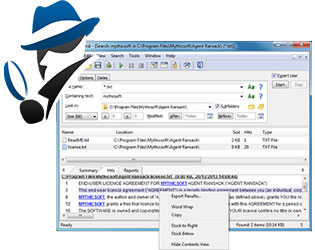Note: This blog post is from 2008. Some content may be outdated--though not necessarily. Same with links and subsequent comments from myself or others. Corrections are welcome, in the comments. And I may revise the content as necessary.

I wanted to share this observation with anyone else who may be suffering the problem--and perhaps not even realize it. I've had a couple of instances where I've noticed that in Outlook (2007, though perhaps in 2003), when I use Advanced Find (ctrl-shift-f) to search my mailboxes, folders, calendars, tasks, or such, it sometimes hasn't found something I know is there.
And in fact, if I repeat the find a few times, sometimes it will go from showing no results, to showing what I expect. Woah! So keep that in mind, if you use.
Similar problem with Spell Check
I'll also note that I've found a similar problem with spell checking, at least the automated one that takes place when I send a message. I've got outlook set to check automatically (tools>options>spelling>always check spelling before sending), and sometimes I know I've typed an error and rather than stop to correct it have relied on the spell check to catch it later. But sometimes it's closed the message (on sending) without pointing out the error.
When I re-open it and do it again (not even a manual spell check, just sending it again), it then does catch the error. Yikes.
Not interested in hearing from nay-sayers
Now, I really don't want to hear from those who will complain about MS products, or Vista, or Outlook, or who would point me to alternative mail clients (like Thunderbird) or ask why I don't use gmail (I do, and I collect it in Outlook). Please, that's not the point of this thread, and some of us have legit reasons for the choices we've made.
Just trying to help others, maybe find a solution
I'm bringing this up here for those who do use Outlook, in case they may have also found they got no results on an Advanced Find search, or who rely on Spell Check. I'm just saying, try the search again a couple of times before giving up. And you may want to open and repeat a spell check if it's an important email.
It's certainly very dismaying that the problem exists. I don't even know where to begin to try to report it effectively.
This quirk about needing to search twice is unfortunate, and can certainly hamper one's trusting its results, but I've resorted to just repeating the search if I don't find something I know is there.
I'm pointing this out here in case others have the same problem, and especially if someone knows a fix. I do Windows Update pretty regularly, so there's not some obvious solution in that regard which I've missed.
Some tips about the features mentioned above
BTW, for anyone interested, Advanced Find can also be found (in 2007 at least) under the Tools>Instant Search menu. And to be clear, I don't use the instant search (or the search box at the top of the mailbox), nor the Search Desktop feature, both also in that menu. I also do not use the Windows Search feature built into the operating system, at all, for files or for email. When I want to search my mail boxes, folders, tasks, calendars, and such, I just use Advanced Find as I so prefer the greater control it affords.
And some of you may wonder, "how do you reopen the email once sent. It always goes immediately when I send". Well, I think that's the default. I always turn off the option, which is in tools>options>mail setup>send/receive>send immediately when connected (don't click the button lablelled send/receive. It's to the left of it.) With this option turned off, email doesn't get sent until you do a send/receive (f5 or tools>send/receive, or it happens automatically as scheduled, as in tools>send/receive>send/receive settings).
The delayed send is a great feature if you ever want to have a chance to reconsider a note actually before sending it, or you think of something just after trying to send it. Of course, sometimes you'll miss out and it will be gone, and of course there's always the drafts feature (just close the message, without sending) if you really aren't yet ready to send.
Anyway, it's a real boon with the problem above to being able to open a message after it's queued for sending to send it again, to trigger the spell check.
Another little trick I use, to catch when the spell check isn't working, is that I always end my messages with /Charlie (set as my signature), and I don't choose the "add to dictionary" option for that. So if a message fails to at least prompt me to correct that, then I know to re-open it and try again.
 Ever need to do a search for files with some given text (or files of a given name) in Windows? I realize you may use a favored file editor to do it, or (worse) may rely solely on the anemic Windows find. I'd like to point you to an awesome and free alternative.
Ever need to do a search for files with some given text (or files of a given name) in Windows? I realize you may use a favored file editor to do it, or (worse) may rely solely on the anemic Windows find. I'd like to point you to an awesome and free alternative.  The tool presents the data aggregated over time, so you can view it per hour, day, week, etc. Great for both drilling down to find hot spots, and for viewing how coding/config improvements (resulting from your responding to the analyses) have led to performance improvements over time.
The tool presents the data aggregated over time, so you can view it per hour, day, week, etc. Great for both drilling down to find hot spots, and for viewing how coding/config improvements (resulting from your responding to the analyses) have led to performance improvements over time.  The tool runs with low overhead: it reads data that the DB provides, storing it in a database and providing a web-based interface to view that data. The process to read the data and create the repository (and present the web-based interface) can (and should) be done on a server separate from the server being monitored.
The tool runs with low overhead: it reads data that the DB provides, storing it in a database and providing a web-based interface to view that data. The process to read the data and create the repository (and present the web-based interface) can (and should) be done on a server separate from the server being monitored.  I wanted to share this observation with anyone else who may be suffering the problem--and perhaps not even realize it. I've had a couple of instances where I've noticed that in Outlook (2007, though perhaps in 2003), when I use Advanced Find (ctrl-shift-f) to search my mailboxes, folders, calendars, tasks, or such, it sometimes hasn't found something I know is there.
I wanted to share this observation with anyone else who may be suffering the problem--and perhaps not even realize it. I've had a couple of instances where I've noticed that in Outlook (2007, though perhaps in 2003), when I use Advanced Find (ctrl-shift-f) to search my mailboxes, folders, calendars, tasks, or such, it sometimes hasn't found something I know is there. 






